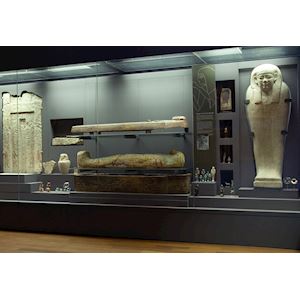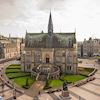
23. EGYPTIAN COLLECTIONS IN DUNDEE AND THE WORLD
In 1882, the Egyptian Exploration Fund – often referred to as the EEF – was established in the UK to raise funds in order to explore, survey and excavate ancient sites in Egypt. Egyptology fired the imagination of Victorian Britain, and The McManus was one of many institutions to subscribe to the Egyptian Exploration Fund in return for gifts of excavated material. The Reverend Colin Campbell, of St Mary’s Church, Dundee was instrumental in bringing these gifts to the City when he became the local EEF secretary. He also encouraged others to donate their collections to the museum. Some of the most important items in this display came from Sir James Caird's personal collection. Caird was a Dundee Jute manufacturer and one of the wealthiest men in the world Object number 4 in the display, is the false tomb door. Caird purchased it from the Cairo Museum. This door was part of an elite Old Kingdom tomb. The hieroglyphs tell us that the tomb was built for Sneferu-inishtef (Sen-f-er-oo-in-ish-tef) Pharaoh’s deputy of the pyramid estate. The tomb consisted of several parts. There were underground burial chambers for Sneferu and his family, and each chamber was entered by a separate shaft. Above ground, a massive brick-built structure, called a mastaba, served as a chapel and could be entered by living relatives. The 'false' or symbolic door of the chapel was the most important feature. Its central panel functioned as a doorway, through which only the spirit of the deceased could leave and re-enter the tomb. If you explore this gallery further you’ll find the Merchant case, where you can see one of the most important Egyptian objects in our collection: the relief of Princess Neferure.(Nef-r-oo-ray) The relief is object 2 in the Merchant case. Princess Neferure was the daughter of Hatshepshut (Hat-shep-suit), who ruled as Pharaoh after the death of her husband. The relief depicts Neferure as Crown Princess. When you’re ready to move on, please continue right, beyond the display case, to the end of the gallery. Here you should find the ship model case.


The McManus: Dundee's Art Gallery and Museum
The McManus: Dundee’s Art Gallery and Museum is situated in the centre of Dundee. The Museum and Art Gallery originally known as the Albert Institute was opened in 1867 as a memorial to Prince Albert. In 2005 The McManus closed for a major refurbishment, reopening again on the 28th February 2010. We celebrated our 150th Anniversay in 2017 with a year of celebration. In 2020 we were awarded Visitor Attraction of the Year by Visit Scotland. The McManus has 8 galleries, which are laid out on 2 floors. Visitors can embark on a journey through 400 million years, and witness how a small settlement developed into the City of Dundee as it is today. From exhibits relating to the life of early man in the area, stunning paintings and decorative art through to artefacts from industries past and present, the City's collections, many of which are recognised as being of national significance, give an insight into Dundee and its people.
- The McManus: Dundee's Art Gallery and Museum
- Dundee United Kingdom
- www.mcmanus.co.uk
